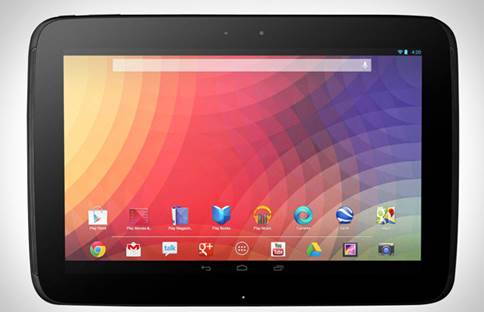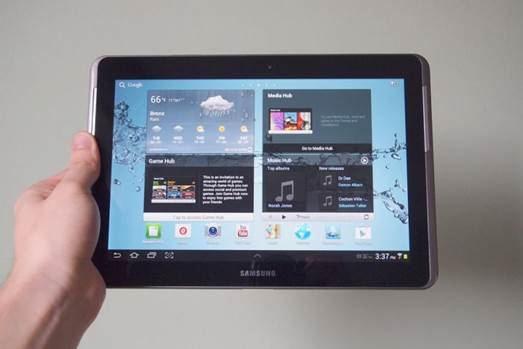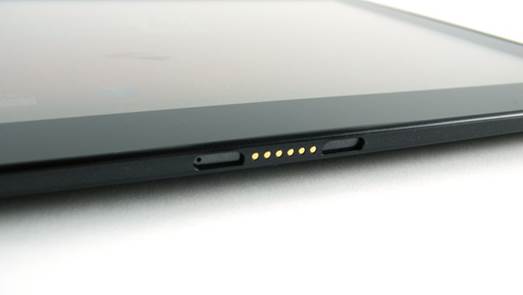When Google unveiled the Nexus 7, we were
completely unexpected. A $200 tablet was reasonably good in all aspects? It
hasn’t been heard yet at that time, and even 5 months later it is still a
really good tablet. Now it has a big brother, the Nexus 10, this was born by
Samsung. For $399, it appears less pompous and a higher price, but also comes
with a special hit: ultra-high resolution.
The 10.1- inch screen has an impressive 2,560x1,600
resolution – it is similar to the 13-inch MacBook Pro with Retina display, but
in a much smaller package. The second reference tablet of Google is a sort of
advanced Android 10-inch tablet at a bargain price, and is it only another big
tablet with a great deal of pixels? The answer is waiting until you read on.

The
Nexus 10, this was born by Samsung. For $399, it appears less pompous and a
higher price, but also comes with a special hit: ultra-high resolution.
Hardware
The Nexus 7, with its rubber back side and
stubby appearance, always felt good for a cheap tablet - but mainly it just
felt very good. The Nexus 10 feels like a completely different monster, which
is not worth being astonished because it comes from a different manufacturer.
Asus was pleased with the first reference tablet from Google; a development
process requires a very tight collaboration with the manufacturers. Now it is Samsung’s
turn that continues the tradition of the Google Nexus to spread love over the
Nexus.
It is an equal partnership, because Samsung
has long been the biggest supporter of Android on the field of tablet, and of
course, because Google has long been fond of the Galaxy Tab 10.1 – by giving
away 5,000 machines at the Google I/O a few years ago. We have been wondering
when Samsung would launch a 10-inch computer without a new stylus, it is due to
the fact that the company has mostly stayed quiet since the Galaxy Tab 2 10.1
was not impressed. We are pleased to say that this model is better. Mostly
better.

This
is primarily a rectangular glass plate with a large number of transistors
stuffed in behind it, but the corners have non-light, large circular shapes.
It starts with a design that obviously
looks like a development of Galaxy Tab 2 10.1, itself very similar to the
Galaxy Tab 10.1N, in which the most notable feature is the two front-facing
speakers. That design language keeps staying here, the grids embedded into the
left and right bezels and extended farther down than they used to, running
through almost the entire vertical area of the tablet.
However, it is difficult to distinguish
these speakers in a sea of very dark materials mixed into an interesting
circular shape. Yes, this is primarily a rectangular glass plate with a large
number of transistors stuffed in behind it, but the corners have non-light, large
circular shapes. Even the sides are slightly curved, bending out to eliminate
any straight lines. This creates a tablet that is incredibly comfortable to
hold in any angles or directions, but it also makes the tablet that looks
bigger than it is in reality.
It is slightly larger than the Galaxy Tab 2
10.1 with the size of 10.39x6.99 inches (263.9x177.6 mm) compared to that
tablet's 10.11 x 6.9. But it is much thinner, just 0.35 inch (8.9mm) vs. 0.38
inch (9.7mm) of its predecessor. That makes it thicker than the Asus Transformer
Pad TF700 Infinity (0.33 inch thick). Meanwhile, for those who prefer the
actual data, it creates one tablet that is slightly higher (0.8 inch), narrower
(0.4 inches) and thinner (0.6 mm) compared to the latest generation iPad. It is
also lighter, with only 1.33 pounds (603g) compared to 1.44 (632g).
That relatively lightness may be due to the
difference in materials, a plastic back dominates the opposite side of this
device. It is covered with a soft coating that feels slightly strange, almost
to the point of being sticky. It does not feel as good as the aluminum layer on
the TF700 and is a definite change from the rippled cover on the back of the
Nexus 7 that both looks nice and feels good. We would like to remind you, a
little trace of this lineage remains here, a rubber strip around the top of the
back that has the style of leather pattern - only with a slightly tighter
dispersion.
That strip is emphasized by the 5MP camera
(capable of 1080p recording), which is mounted next to the LED flash. If you
want to take a look at more of these two things, you can actually completely
remove that plastic strip, which also reveals the name FCC of the tablet and
all kinds of other internationally entrusted logos are neatly tucked away,
which makes the back almost flawless. We wish Google would start using such
shells to hide the network flashy branding on the Android phones.
At the top edge of the tablet, you will
only find two physical controls, a volume rocker and a power/lock button.
Around the corner to the left, you will find a micro-USB port and a 3.5mm
headphone jack. On the bottom there is a six-pot pin connector and on the
right, a very welcomed micro-HDMI port to transfer all your legal video content
to a larger screen. Contrary to our expectations, there is no way to transmit
wireless video from this tablet, but we'll talk more about that later in the
review.

On
the bottom there is a six-pot pin connector and on the right, a very welcomed
micro-HDMI port to transfer all your legal video content to a larger screen.
At the front of the device is a suite of
nice large stereo speakers. In the top of the screen bezel is 1.9MP camera
(capable of 720p video recording), and the bezel below is the RGB notification
LED light.
And of course, there are interesting things
inside. Power supply for this tablet is a 1.7GHz chip of the A15Eagle version.
That processor architecture can achieve quad core capacity, but this especial
processor sits in a dual-core configuration. Sitting next to it is a Mali T604
GPU and 2GB of RAM along with 16GB or 32GB of storage, depending on whether you
paid $399 or $499. None of them can expand.
There are no mobile models, so Wi-Fi will
be your only connection to the world. Thus, this tablet is reasonably equipped
with dual-band and MIMO and HT40 support over b/g/n. (Sorry, 802.11a is
excluded). You also have GPS, Bluetooth 4.0, and NFC on the front and the rear.